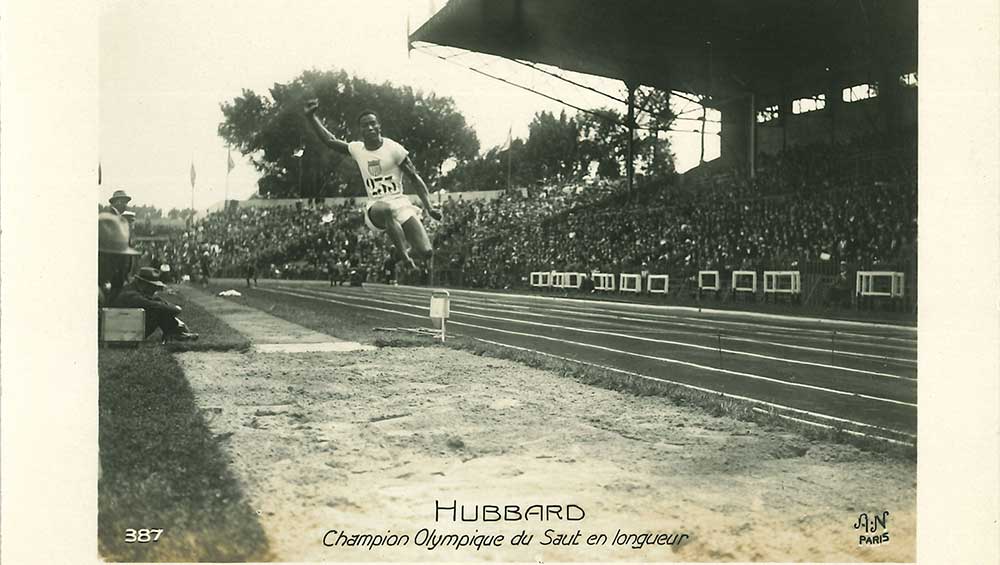
Postcard, Hubbard, Olympic Champion of the long jump (A.N. Paris series, no. 387), 1924. Unknown photographer. Gelatin silver print on paper.
Fitzwilliam Museum, Cambridge
19 July – 3 November 2024
by JOE LLOYD
The Olympics now is as solid as a marble sculpture. Every four years, international athletes descend on a city adorned with glittering new, or at least buffed-up, stadiums and arenas. Viewers marvel at the achievements of previously unknown swimmers, pole-vaulters and race walkers for a fortnight, before shelving them in the back of their mind until the next time. A hundred years ago, though, the Olympics had yet to gain a stable form. The first modern Games were held in 1896 at Athens, and included only European and US men. Early editions had an arts section modelled on their ancient inspiration, with prizes for architecture, literature, music, painting and sculpture.
The 1924 Summer Olympics in Paris continued this strand. But it also saw the Games leap towards their now modern form. Forty-four nations from five continents competed, including female athletes. The motto Citius, Altius, Fortius (faster, higher, stronger) was introduced. The marathon distance and 50m pool were fixed. The US inevitably won the most medals. For the first time, the event was broadcast live on radio with commentary in France, while radio stations in other countries ran highlights. Newspapers pictured and caricatured athletes, granting them celebrity status. The Games saw the race that inspired the film Chariots of Fire more than half a century later. William DeHart Hubbard triumphed in the long jump, becoming the first black athlete to win gold in an individual event. It also inaugurated the phenomenon of agonising over the hosting costs: it lost about half its 10m-franc budget, in part because the tickets were deliberately priced over the heads of working-class Parisians and the main stadium was in a “smoky industrial suburb”.
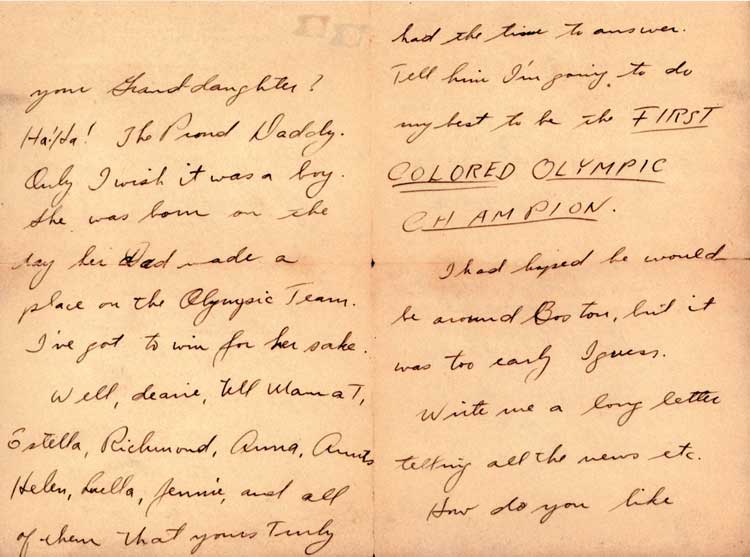
Letter written by William DeHart Hubbard (1903–1976) to his mother on board the SS America before sailing to Paris with the US Olympic team, 16 June 1924. Pen and ink on paper with printed letterhead. DeHart Hubbard Collection, MSS 1067, Cincinnati Museum Center.
Paris, write curators Caroline Vout and Christopher Young, “marks the moment when individual athletes from a range of sports and nations could, through the course of a single sporting event, have impact around the world”. Their exhibition at the Fitzwilliam examines how this breakthrough corresponded and interacted with a mounting visual culture that explored the muscular bodies and balletic movements of athletes. There are posters, postcards, tickets, passports, cigarette cards, medals, record bags and period sports shoes.
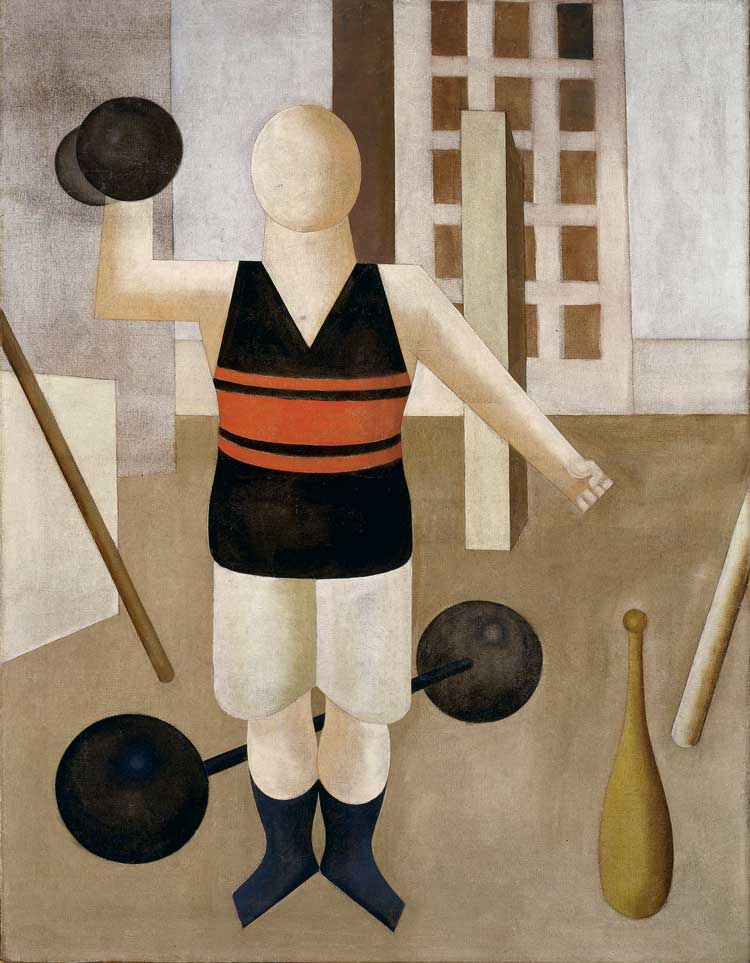
George Grosz. The Gymnast, about 1922. Oil paint on canvas. Collection of the McNay Art Museum, Gift of Robert L. B. Tobin, 1974.26. © Estate of George Grosz, Princeton, N.J. / DACS 2024.
There is also art. In the years preceding Paris, André Lhote turned tennis players into cubist constructions (1917), George Grosz depicted a pin-shaped gymnast as a blank-faced automaton (c1922), and Pablo Picasso doodled over a newspaper image of Tour de France winner Henri Pélisier (1923). The influence of sport dribbled into the ways artists depicted bodies. Umberto Boccioni’s celebrated sculpture Unique Forms of Continuity in Space (1913) was allegedly inspired by a passing footballer.
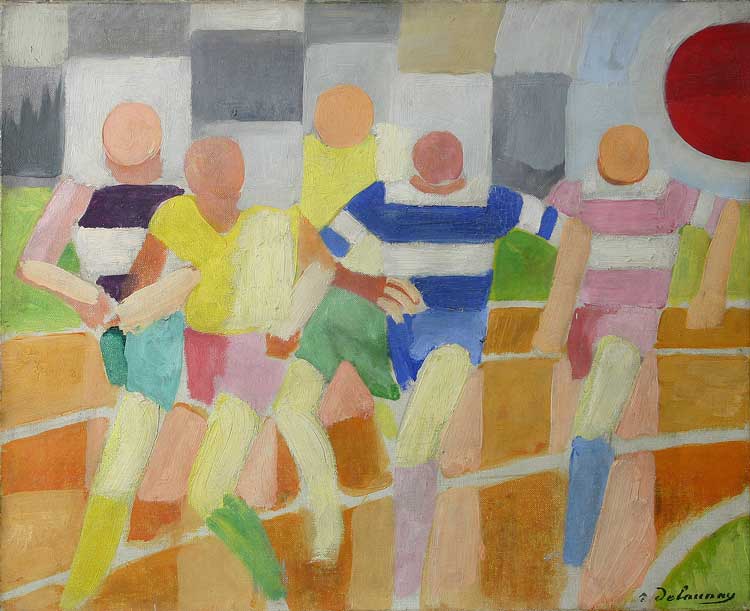
Robert Delaunay (1885–1941). The Runners, about 1924. Oil paint on canvas. National Museum of Serbia.
In 1924, Paris was still the reigning champion of the art world. One of its leading lights, Natalia Goncharova, organised an Olympic Ball to celebrate; she sketched a dress for “men and women in a hurry” on the back of the flyer. Another was directly inspired. Robert Delaunay’s The Runners, present here in a version loaned from Belgrade (c1924), immortalised the participants of the 1,500m final. Delaunay may have seen the event, but the painting’s perspective – from the track itself, in front of the athletes as they surge ahead – was impossible. Delaunay’s work may, instead, be based on press photography, a mechanical medium for a mechanical era.
The winners of the Olympic Art Competition itself were rather different. The gold medal went to Luxembourger Jean Jacoby for his triptych Etude de Sport (1924). Jacoby was a commercial sports illustrator, and his depictions of rugby and football are kinetic and conventional, focusing on movement over detail. The one avant garde artist who did succeed in any of the competitions, taking him silver in Paris, was Jack Yeats. His The Liffey Swim (1923), shown at the Olympics as simply Swimming, places a race in the heart of the city. His swimmers are wiggly slivers of paint. The focus is instead on the crowd looking on, art in the age of mass spectacle.
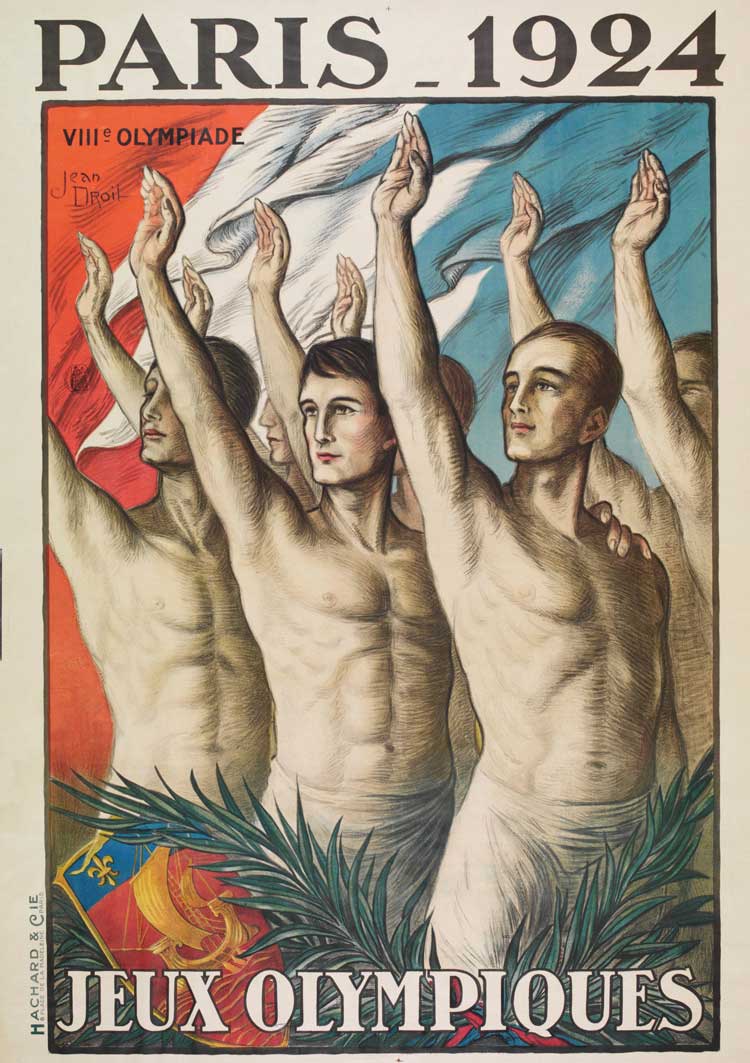
Poster for the Paris 1924 Olympic Games. Jean Droit (1884–1961). Printed by Hachard & Co., Paris. Colour lithography on paper. © Victoria and Albert Museum, London.
The artistic mode that most characterised the Olympics, however, was a devotion to the nude body. Jean Droit’s official Paris 1924 poster features a row of pale, topless men raising their hand in the Olympic salute, a gesture based on the Roman salute that has since been shelved for its resemblance to the Nazi Sieg Heil. Gold medal winners at Paris received a Sevres vase with nude figures redolent of those on Attic vases. Pierre de Coubertin, founder of the modern Olympics, lionised both Ancient Greece and the playing fields of English schools, designed to inoculate an almost militaristic discipline. He found beauty in “poise and proportion”. The Olympics helped to popularise a muscular ideal of beauty derived from Greek sculpture. This would reach its apogee with Leni Riefenstahl’s notorious film Olympia (1938), which opens with Myron’s celebrated Discobulus (c460-450 BC) transforming into the German Olympic athlete Erwin Huber.
.jpg)
Johnny Weissmuller (1904–1984), posing for artist John Hubbard Rich (1876–1954), about 1931. Photo: Pach Brothers. Gelatin silver print. National Portrait Gallery, Smithsonian Institution, Washington.
This iconography did not just exist in fascist countries. In 1932, the Austro-Hungarian-born American swimmer Johnny Weissmuller posed as the Discobulus for an MGM shoot; he was about to trade up his sporting success to become a Hollywood star, playing Tarzan. The poster for the 1948 London Olympics superimposes Myron’s sculpture on the Palace of Westminster. But even in 1924 the contest was already revealing a rising tide of divisive nationalism. By grouping competitors by nationality, Coubertin’s system inevitably foregrounded the sense of competition between countries. At Paris, the Italian fencer Oreste Puliti and his teammates sang a fascist song as they left after a dispute with referees.
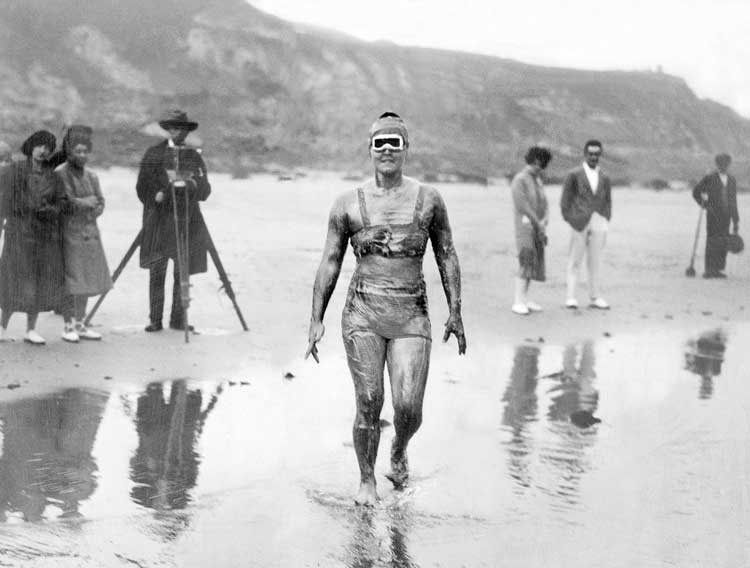
Gertrude Ederle, 6 August 1926. Black and white photograph. © New York Daily News Archive / Getty Images.
The Fitzwilliam does not shy away from these more unsavoury aspects of the 1924 contest. It is especially engaging when looking at the social phenomenon that sprang out of it. Among the most fascinating subjects are the individual athletes whose performance shot them to celebrity status. The Finnish runner Paavo Nurmi, who won all five races he entered, became a hero at home and abroad. The Polish poet Kazimierz Wierzyński wrote a verse from Nurmi’s perspective. Sculptor Wäinö Aaltonen rendered him in bronze (1924). The image became so iconic that, in the early 1950s, Aaltonen created mass-produced smaller versions to fund Helsinki 1952’s Olympic village.
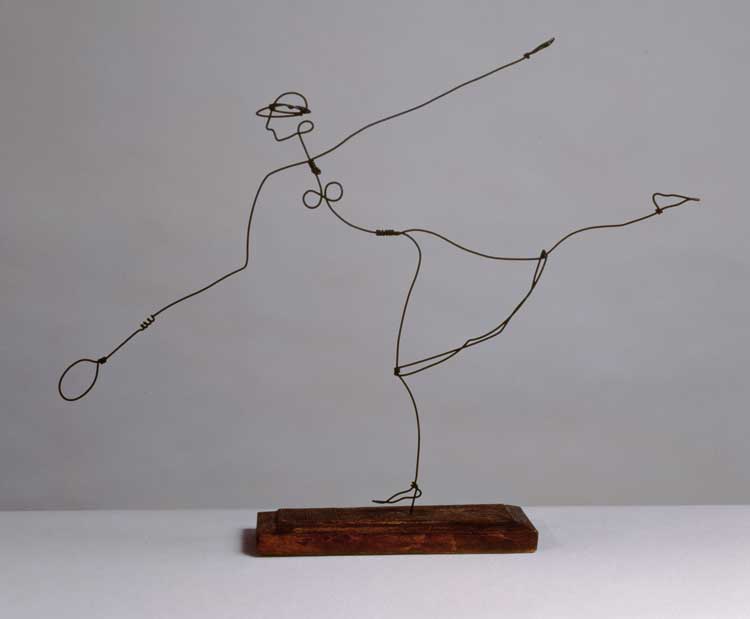
Alexander Calder. Helen Wills I, 1927. Wire and wood. Photo courtesy of Calder Foundation, New York / Art Resource, New York. © 2024 Calder Foundation, New York / DACS, London.
American tennis gold medallist Helen Wills was another star. Alexander Calder turned her into a wire sculpture (1927) while the Mexican Diego Rivera painted her as the presiding figure in his mural at the San Francisco Stock Exchange (1931), represented here by an enormous preparatory drawing. Wills’ French rival, Suzanne Lenglen, would turn up wearing silk, jewellery and makeup. One American newspaper compare her to “those Spartan girl athletes we still see in marble across the ages”. Female athletes were both sainted and sexualised, served up for the male gaze. In the exhibition catalogue, Vout quotes a queasy text by Henry de Montherlant, in which the writer froths with eroticism while watching a masseur massage a runner’s legs. Montherlant, a serial abuser of young boys who would later praise the German occupation, sent the story to Paris 1924’s literature competition.
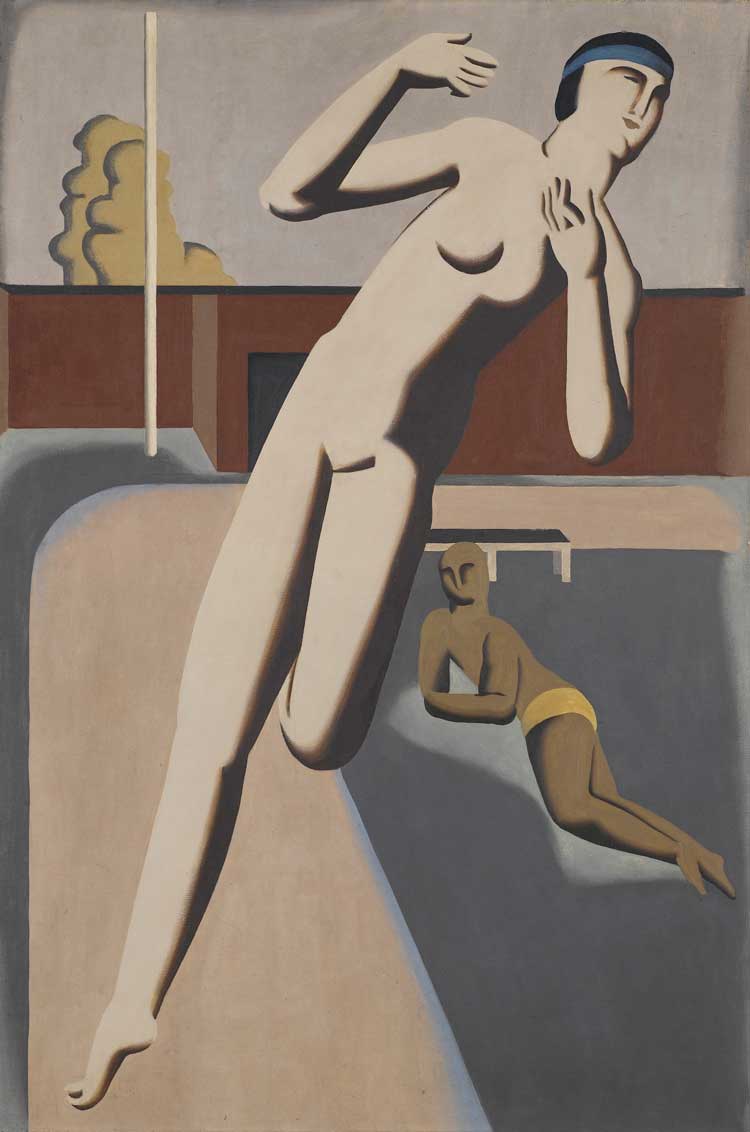
Willi Baumeister (1889-1955). Female Runner II, 1925. Oil paint on canvas. Photo: Scala, Florence/bpk, Bildagentur für Kunst, Kultur und Geschichte, Berlin. © DACS 2024.
Many of these problems – the Olympics as a nationalist demonstration, the sexualisation of athletes, the Games’ agonising costs – remain today, albeit in altered forms. One thing that has changed significantly is the way the Olympics is represented and represents itself. The serried ranks of topless Adonises gave way in the 1960s to abstracted national symbols on a white background. Paris 2024 is little exception, though it has recently revealed poster designs that integrate Delaunay’s prismatic discs. Film and photography have long become the primary medium for depicting sport. And athletics is no longer terra nova. Running has become an everyday pastime. But this exhibition reveals just how creative, political and forward-facing sports once appeared – and how deeply it has embedded itself in our societies.